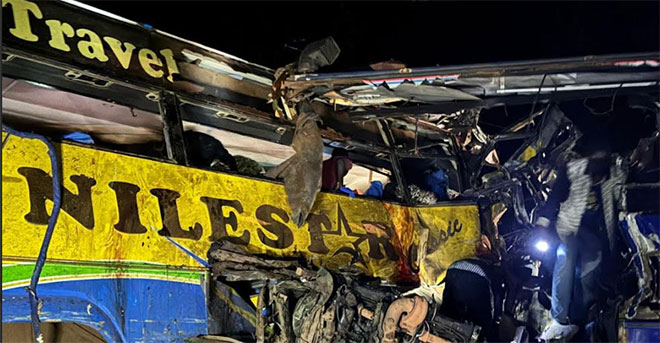Copyright independent

A bus driver’s tale of plying the Kampala-Gulu highway COVER STORY | RONALD MUSOKE | A long-haul bus rolls into Namayiba Bus Terminal in downtown Kampala from the northwesten city of Arua. The driver, who requests anonymity for fear of repercussions from bus companies and authorities, has just completed a grueling journey along the Kampala–Gulu highway. He has driven through the night, as he does most nights, navigating a road that has become synonymous with death. He heard the news a few days ago of another horrific accident, this time at Kitaleeba Village near Asili Farm in Kiryandongo District: 46 people dead, scores injured; all in a crash that involved two buses overtaking recklessly, colliding head-on, and triggering a chain reaction with other vehicles. As three youngmen lie under the belly of his bus to service it in preparation for the night trip back to Arua, the driver shows disinterest in talking to The Independent when I introduce myself to him and the topic at hand: the road carrnage on the Kampala-Gulu highway. He shrugs me off saying he needs to rest but a few moments later, he changes his mind and comes back to talk to me. “People think we (bus drivers) are the problem,” he says quietly, his voice tinged with exhaustion and frustration. “But they don’t know what we face on these roads: lorries that break down and stay stationary on the road for hours, passengers who want to get to their destinations faster, and wild animals (in a section of Murchison Falls Conservation Area) that cross the highway at night. We are the ones paying with our lives, yet the system blames us,” he says of the road that he has driven on for 20 years. The Namayiba Bus Terminal in Kampala, Uganda’s capital, serves as a temporary haven. Both local and interstate buses arrive and depart with clockwork precision, a stark contrast to the chaos that unfolded just days ago on the Kampala-Gulu highway. For this driver, it was a reminder of the fragility of life on Uganda’s roads, where each journey could be the last. A highway of horror The Kampala–Gulu highway is more than a road; it is a lifeline for northern Uganda, linking Kampala to towns and districts across the region and beyond including South Sudan and DR Congo. But it is also a corridor of death. A quick review of road crashes over the past decade reveals a grim pattern: head-on collisions, night-time crashes, and catastrophic pile-ups that leave dozens dead. In August 2014, two buses collided head-on at Nakasongola, killing seven and injuring twenty. In May 2018, a Gaaga Bus traveling from Lira rammed into a tractor in Kiryandongo, killing 23. November 2019 saw a KK bus collide with an HMK bus near River Kafu, leaving one dead and twelve injured. In March 2021, a coach of Zawadi Bus Services collided with a Gulu-bound trailer, killing four and injuring at least 20. Early January 2023 saw a Valley Company bus crash in Bamusuuta village, injuring seventeen. In June 2023, five people died in a collision involving a bus and a charcoal truck at Migyeera. Each incident echoes the same failures: a narrow road, poor enforcement, and systemic neglect. The driver’s eyes darken as he speaks of the highway’s hidden dangers. “The road is not just narrow; it’s alive with hazards. Trucks break down and stay there for hours. Sometimes you only see them at the last moment. And at night, animals wander from the park, elephants, hippos, but passengers demand you drive faster. They don’t see the danger. They only see their schedule.” Herbert Kamoga, a journalist who works with national broadcaster, NTV, and is based in the Greater Luweero sub-region through which the Kampala-Gulu highway passes, describes the stretch between Nakasongola and Kiryandongo as deceptively flat and clear. “Drivers are tempted to speed. Combine that with deteriorating road conditions; potholes, and lack of signage, and you have a recipe for disaster,” he says. The Kiryandongo tragedy The crash at Kitaleeba Village occurred around 12:15 a.m. on October 22. Four vehicles were involved: a Nile Star Bus (UBF 614X), a Planet Company Bus (UAM 045V), a Tata Lorry (UBK 647C), and a Toyota Surf (CGO 5132AB07). Preliminary investigations by the Police revealed that reckless overtaking triggered a head-on collision between the two buses. The Tata lorry and Toyota Surf were caught in the aftermath, compounding the devastation. Police promptly arrived at the scene, evacuating the injured to Kiryandongo Hospital and other nearby medical facilities. Deceased victims were conveyed to the hospital mortuary for post-mortem and identification. The Police later in the day confirmed that 46 people lost their lives, while several others sustained serious injuries. The Uganda Professional Drivers Network (UPDN) decried the tragedy. “Every life lost on our roads is one too many. This tragedy underscores the urgent need to strengthen driver discipline, enforcement of traffic laws, vehicle roadworthiness, and responsible road use among all road users,” read the statement signed by the Executive Director Ndugu Omongo on Oct.22. But for bus drivers who navigate this route nightly, the blame is often misdirected. “It’s dishonest to say all accidents are the drivers’ fault,” the anonymous driver told The Independent. “The police, the transport ministry, the breakdown services — they all have roles. We are out here risking our lives every night.” The human cost Hospitals were overwhelmed in the wake of the Kiryandongo crash. The Uganda Red Cross Society and ambulances ferried victims, while relatives searched frantically for loved ones throughout the day. President Yoweri Museveni extended condolences and ordered that Shs 5 million be given to each bereaved family, and Shs 1 million to the injured. But gestures and payouts, while necessary, do not address systemic failures. Police data shows that 25,107 road traffic crashes were recorded in 2024, a 6.4% increase from the previous year, resulting in 25,808 casualties. Head-on collisions, the type that killed 46 in Kiryandongo, comprised 13% of these incidents. “People call us mad, drug addicts and reckless, but we are often victims of the system,” the driver says. “We drive long hours with pressure from owners, passengers, and the road itself. When accidents happen, we are blamed, but the dangers are everywhere — potholes, broken-down lorries, and wildlife.” He says most passengers along this route prefer to travel at night. Many are businesspeople who prefer to travel in the night, do business during the day and return to Kampala at night. Quite often, many are time conscious and want the bus drivers to drive faster. And because the competition on this route is quite high (there are at least six bus companies plying this route), sometimes the bus drivers succumb to this pressure. “For many of us, we drive when we are angry,” he says. He adds that there are instances where his colleagues have lost jobs on account of driving slowly along the route. The nearly 500km Kampala-Arua route takes the bus driver close to nine hours. If the driver sets-off at 9:00pm, the bus should arrive in Arua at around 5:00am or 6:00am. Arriving at 7:00am would be considered late. “We do our work under too much pressure,” he says, “We are like soldiers but we also work in a very challenging environment.” The bus driver mentions abuse from the bus company owners, majority of whom, he says, are Members of Parliament, ministers as well as high-ranking security officers. “Someone gives you a job, you agree on a salary but they reneges on payment for six months, all the while biding their time for you to make a mistake so they fires you. Others will give you a job but will say we are giving you Shs 50,000 per route you complete as your take home. But remember you have a family back home. If you don’t work, they won’t eat,” he told The Indeendent. “This morning, on my way from Arua, when I was around Nakulabye here in Kampala, I hooted to get a woman off the road, she ended up hurling insults at me, saying I am a murderer who just killed people in the bus crash in Kiryandongo but I don’t work for Planet Bus Company or Nile Star,” he says. Still, Sam Bambanza, the Executive Director of Safe Transport and Survivors Support-Uganda, a Kampala-based non-profit, highlights the weaknesses in enforcement. He says night buses are sometimes driven by turnboys while the actual drivers rest. He says Police Checkpoints, too, rarely engage passengers to identify errant drivers, and some bus companies, often politically connected, exert influence over law enforcement. “Drivers are human,” Bambanza told The Independent. “Our bodies get tired. The night buses are also overloaded because the police aren’t on the road.” He says traffic enformcement are weak and the system is easily manipulated. “Until we address these structural failures, tragedies will continue,” he says. The anonymous driver echoes this sentiment. “We work under pressure, and if we slow down, we risk losing our jobs. Bus owners want results, passengers want speed, and the road gives no mercy. When the Ministry makes plans, they stay in offices. We deal with reality on the highway.” Infrastructure challenges Uganda’s roads exacerbate the problem. The Kampala–Gulu highway is narrow, with minimal signage, and few opportunities for safe overtaking. It is a relatively old road that is deteriorating in some sections, with potholes and uneven surfaces, making night driving perilous. “Drivers have to negotiate a narrow flat highway with a relatively increasing vehicle trafffic with minimal traffic enforcement, and this tempts them to speed and the combination is deadly,” Kamoga told The Independent . Bambanza also notes that the signage in some sections of the highway often misrepresents safety. “ If we had a proper four-lane highway with modern safety measures, many collisions could be avoided,” he said. Expert perspectives Dr. Esther Bayiga (PhD), a road safety researcher at Makerere University School of Public Health, emphasizes multi-sector collaboration. “We need the Ministries of Works and Transport, Health, Police, and IT to coordinate. Enforcement alone is not enough. What happens at night when police aren’t there? How do we manage emergency response?” she told NTV in the aftermath of the Kiryandongo crash. Irene Namuyiga, the General Manager of Safe Way, Right Way, a non-profit that promotes road safety on Uganda’s road networks recommends stricter regulation of long-distance buses, including mandatory biannual inspections, two drivers on night routes, and annual health and skills assessments. “These buses are essentially our public transport. They need the same oversight, and drivers require structured rest and medical checks,” she told The Independent. She recomemmends buses and drivers to undergo a biannual inspection and medical tests, respectively, considering a lot can change within six months, and yet early detection could save lives, especially considering the number of passengers involved in bus crashes. “After every inspection, a driver or operator should present evidence that any issues identified have been corrected — proof of repairs or maintenance carried out.” “We also need to regulate drivers more strictly. Many of these buses cover long distances, sometimes up to 350 kilometres or more per trip, and in some cases, close to 1,000 kilometres a day. That’s far beyond what is safe or humanly sustainable.” Namuyiga says drivers get fatigued —particularly at night — when the body naturally needs rest. To address this, she says there should be a mandatory driver change at the destination, meaning a different driver takes over for the return journey. “Alternatively, each bus, especially those operating at night, should have at least two drivers onboard. This allows one to rest while the other drives, ensuring alertness and safety throughout the journey.” Namuyiga also recommends mandatory annual training and assessment for all bus drivers. This,she says, shouldn’t only focus on road safety and defensive driving but also include health screening. “Some drivers may have underlying health conditions — such as poor eyesight or chronic illnesses — that can affect their ability to drive safely. Annual medical and skill assessments would help identify and address such issues early,” Namuyiga adds. Andrew Mwase, a road safety advocate, focusing on post-crash failures says, quick response is key to saving lives in a road crash. “At least 15 people were declared dead when they were only unconscious. How many could have been saved if first responders had accurate information? ” he told The Independent. “The responsibility ultimately lies with government policy and resource allocation to health and emergency systems.” In a statement published on Oct. 23 by the Ministry of Works and Transport, investigations continue to establish the full circumstances surrounding the tragedy. “As soon as the investigations are completed, we shall update the public on the findings, actions taken and way forward,” Edward Katumba Wamala, the Minister of Works and Transport. Accountability and reform But despite repeated crashes, long-distance bus operators are rarely sanctioned, and crash-audit findings remain unpublished. Advocates call for stricter licensing, night-travel restrictions, routine mechanical inspections, black-box tracking, speed cameras, and transparent audits. Mwase says its not a one fact solution. “The government must act across all fronts -roads, enforcement, driver training, vehicle safety, and post-crash care, or these deaths will continue,” he said. “Sadly, nobody is talking about the Kiryandongo bus crash anymore until we get another.” He adds: “But I believe the Ministry of Works and Transport and the Ministry of Internal Affairs have a duty here,” he says. “There’s a duty to have people trained to investigate, find the causes of each incident and then as policy we find solutions that can reduce or even avoid the same or similar incidents happening from the same known causes.” Technological solutions Dr. Bayiga says road crashes attract the highest casualties in emergency departments. “If we want to save lives, every sector — health, transport, police, IT — must work together. Fragmented responsibility is a death sentence,”she told NTV. Mwase and Bambanza further suggest that technology could be key. First, Mwase says, the automatic monitoring system which has been under suspension since June this year because of the public outcry over the Express Penalty Scheme (EPS) would most likely have given the investigators some evidence via camera on the speed of the vehicles involved. Going forward, Bambanza says cameras on buses linked to a central monitoring system could track speed, driver fatigue, and overtaking behaviour. Tanzania’s vehicle tracking system, he says, serves as a model; it monitors bus speed and routes, reducing reckless driving and aiding post-crash investigations. “Currently, investigations rely on guesswork and witness accounts,” Bambanza says. “Black boxes and cameras could prevent crashes and assign responsibility accurately.” Back at Namayiba Bus Terminal, as I bid farewell to let the bus driver rest before he departs for yet another night route later in the day, the driver pauses, gazes at me and says: “We drive on this road every day. We fear the nights, the lorries, the potholes, the animals. We fear mistakes we cannot prevent. But the people above — the police, the ministry, the bus owners — they make the rules. And when rules fail, we pay,” he said. “There is a time when the bus drivers wanted to have a meeting with the bus owners with the Commissioner for Transport Regulation and Safety in the Ministry of Works and Transport so we could air out our grievances but it never materialized. We were instead met separately.” For this particular driver and many others, the Kampala-Gulu highway waits, indifferent to human life, and those who traverse it do so at the mercy of circumstance and system alike.



